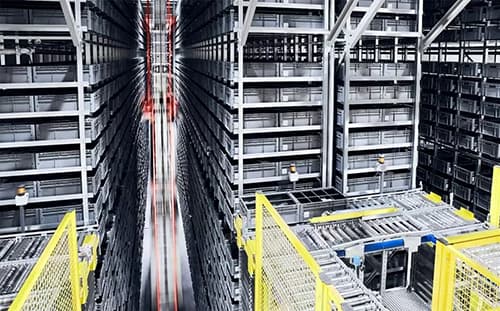Les progrès technologiques, tels que la robotique, les systèmes d’automatisation et l’intelligence artificielle, ont permis le développement d’entrepôts hautement automatisés. Un entrepôt entièrement automatisé implique généralement l'intégration de diverses technologies et systèmes pour exécuter des fonctions telles que la réception, le stockage, le prélèvement, l'emballage et l'expédition avec une intervention humaine minimale.

Voici quelques composants et technologies clés qui contribuent à l’automatisation d’un entrepôt :
1. Système automatisé de stockage et de récupération (ASRS): Les systèmes ASRS utilisent des grues ou des navettes robotisées pour stocker et récupérer automatiquement les articles dans les emplacements de stockage désignés. Ces systèmes peuvent optimiser l'utilisation de l'espace, améliorer la gestion des stocks et permettre une exécution rapide et précise des commandes.
2. Véhicules à guidage automatique (AGV) : les AGV peuvent transporter de manière autonome des marchandises au sein de l'entrepôt, éliminant ainsi le besoin de manutention manuelle des matériaux. Ils peuvent naviguer dans l'installation à l'aide de capteurs et suivre des itinéraires prédéfinis ou ajuster dynamiquement leurs itinéraires en fonction d'informations en temps réel.
3. Systèmes de convoyeurs : les systèmes de convoyeurs automatisés peuvent déplacer les articles le long d'un chemin prédéterminé, facilitant ainsi la circulation fluide des marchandises dans l'entrepôt. Ils peuvent être intégrés à d’autres technologies d’automatisation, telles que des AGV ou des robots de prélèvement, pour garantir une manutention efficace des matériaux.
4. Robotique et systèmes de prélèvement et de placement : des systèmes robotiques avancés, notamment des bras robotisés et des pinces, sont utilisés pour des tâches telles que la préparation des commandes, le tri, l'emballage et la palettisation. Ces robots peuvent gérer une large gamme d’articles et améliorer la productivité et la précision des opérations d’entrepôt.
5. Système de gestion d'entrepôt (WMS) : Un WMS est une application logicielle qui contrôle et gère divers aspects des opérations d'entrepôt. Il coordonne les activités des différents systèmes d'automatisation, optimise les stratégies de stockage et de prélèvement des stocks et fournit des informations en temps réel pour une prise de décision efficace.
6. Internet des objets (IoT) et capteurs : des appareils et des capteurs IoT peuvent être déployés dans tout l'entrepôt pour collecter et transmettre des données sur des paramètres tels que les niveaux de stock, l'état des équipements, la température et la sécurité. Ces données peuvent être utilisées pour la surveillance, la maintenance prédictive et l'optimisation des opérations globales de l'entrepôt.
Bien qu'une automatisation complète soit possible, le niveau d'automatisation mis en œuvre dans un entrepôt dépend de facteurs tels que le type de marchandises manipulées, les volumes de commandes, les contraintes d'espace, le budget et les exigences opérationnelles.
Par Amy

Add: NO.409 West Jianshe Road, Economic Development Zone, Jinhu County, Jiangsu Province, China
droits d'auteur
2026@ Jiangsu Kingmore Storage Equipment Manufacturing Co., Ltd Tous les droits sont réservés.
Plan du site
| Blog
| Xml
| politique de confidentialité
 RÉSEAU PRIS EN CHARGE
RÉSEAU PRIS EN CHARGE